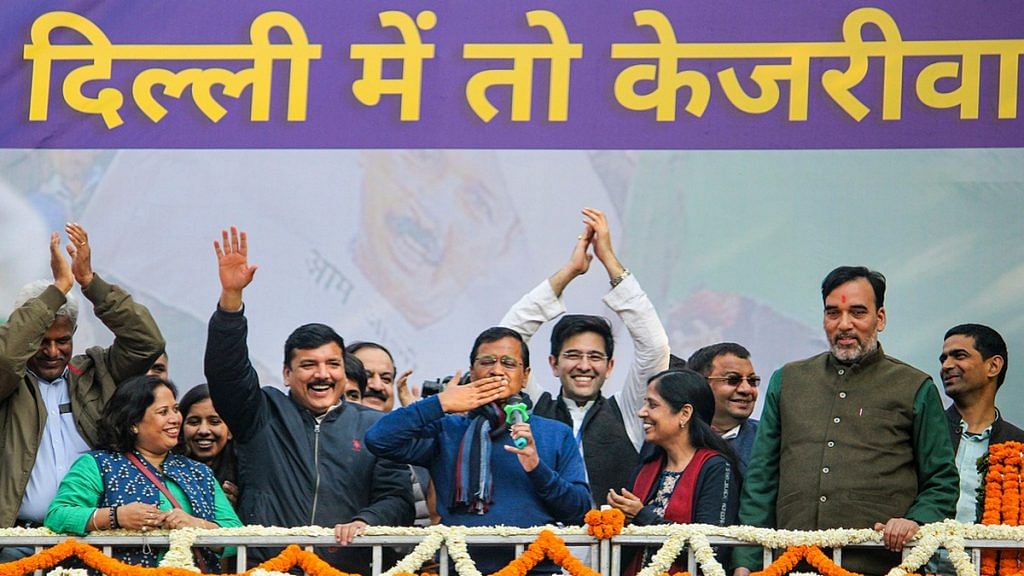The people of Delhi have once again given a huge thumbs up to the AAP school of politics, while the BJP’s high-voltage campaign, led by Home Minister Amit Shah, failed miserably.
In a way, the AAP has conveyed a direct message to the BJP — that elections can be won despite adhering to one’s own ideology and politics in the face of provocation, without compromising with values, and by following a strong leadership.
In 2014, under Modi’s stellar leadership, the BJP paved its way into the hearts and minds of India’s electorate, led by the slogan, “Chal, Charitra and Chehra (conduct, character and face)”.
Now, it appears that the AAP and Kejriwal have completely imbibed this mantra to give a new sheen to its politics.
The BJP, meanwhile, appeared baffled and bewildered. It tried to win the Delhi polls on the basis of its organisational muscle but failed.
With this victory, the AAP has conveyed an important lesson to the opposition — that one should contest elections on the basis of their own “Chal, Charitra and Chehra”. The party carried out a campaign driven by a positive narrative and emphasised that its appeal should suit the mood of people at large. The strategy paid off.
Here are the top reasons for this emphatic victory of the AAP.
Also read: What Delhi can look forward to from new AAP govt — Deshbhakti course, more welfare schemes
Chal
Kejrwal, who fought this election by presenting himself as “Delhi ka beta (son of Delhi)”, had mended his way in the months leading up to the polls.
Several political analysts term it the “Prashant Kishor effect”.
The main idea behind Kejriwal’s transformation was to stay away from the opposition’s agenda and follow his own roadmap. It helped the AAP avoid traps and political minefields set by the opposition, and to not deviate from its own line and mount impulsive reactions.
Charitra
During the entire campaign, Kejriwal presented himself as a humble servant of Delhi while cleverly positioning his party as the capital’s own — one solely concerned about the geographical boundary of the national capital and trying to serve it in every possible way.
The party kept repeating that it should be elected to govern Delhi, just as the people have voted for Modi and the BJP in the Lok Sabha polls.
The AAP learnt a hard lesson from the last Lok Sabha election — not to be too impatient.
In the 2014 Lok Sabha polls, Kejriwal went to Varanasi to contest against PM Narendra Modi and tried to take his party to the national level. The strategy flopped.
Kejriwal, then, apart from checking his own over-ambitious manner, also set a fixed goal for himself and the party.
Chehra
Over the past five years, Chief Minister Kejriwal emerged as a powerful face of Delhi. Neither the BJP nor the Congress could present any face (leader) to challenge him. The opposition’s biggest drawback was the absence of a credible face to challenge Kejriwal.
In this, people saw a message: That Kejriwal had been with them constantly over the past five years but the BJP had failed to even zero in on a face for its campaign — Delhi BJP chief Manoj Tiwari, Union minister Harsh Vardhan, or Delhi MP Parvesh Verma, or anyone else. This proved costly for the party.
Then again, for the last 21 years, the Delhi BJP has failed to produce a formidable local leader with the kind of its repute its former chief ministers Madan Lal Khurana and Sahib Singh Verma courted.
Also read: Delhi election verdict is a ‘referendum’ on Kejriwal’s development & not against Modi
The politics of freebies
The AAP government’s freebies — free electricity, free water, free bus travel for women — are being talked about not only in Delhi but across the nation.
People belonging to the lower strata benefited heavily from such schemes. The decision to make DTC buses free for women proved to be a trump card for Kejriwal. As far as electricity is concerned, the Delhi government first raised the rates, then heavily subsidised usage up to a certain level.
In short, it collected hefty sums from people using more electricity (usually higher-income groups), and passed on the benefits to poor people in the form of free electricity.
The BJP lost out because it couldn’t take on the AAP on this front. On the one hand, it proved to be politically impossible to speak against this “freebie culture” and, on the other, the BJP could not promise any additional freebies from its own kitty.
After the party’s crushing defeat in the Delhi elections, BJP leader and Haryana minister Anil Vij tweeted a rebuke to the capital’s “penchant for freebies”.
Development vs Shaheen Bagh
Towards the last leg of the campaign, the BJP tried hard to polarise the electorate. It deviated from its development agenda and tried to raise the Shaheen Bagh bogey.
A deliberate attempt was made to turn the entire campaign into a Shaheen Bagh vs nationalism debate.
At almost every political rally, BJP leaders issued anti-Muslim statements and accused the AAP of appeasement politics. But Kejriwal foiled the BJP’s trickery by sticking to his developmental claims and positive agenda.
He kept his focus on initiatives in the health and education sectors, like mohalla clinic etc. He did not deviate from his agenda even to counter “sting operations”.
Kejriwal kept reminding the people about the work his government had done while the main opposition, the BJP, kept raising issues like the CAA, nationalism, treason etc.
Also read: How Kejriwal gamed Modi, Shah’s Hindutva-nationalism-welfarism combination to defeat them
